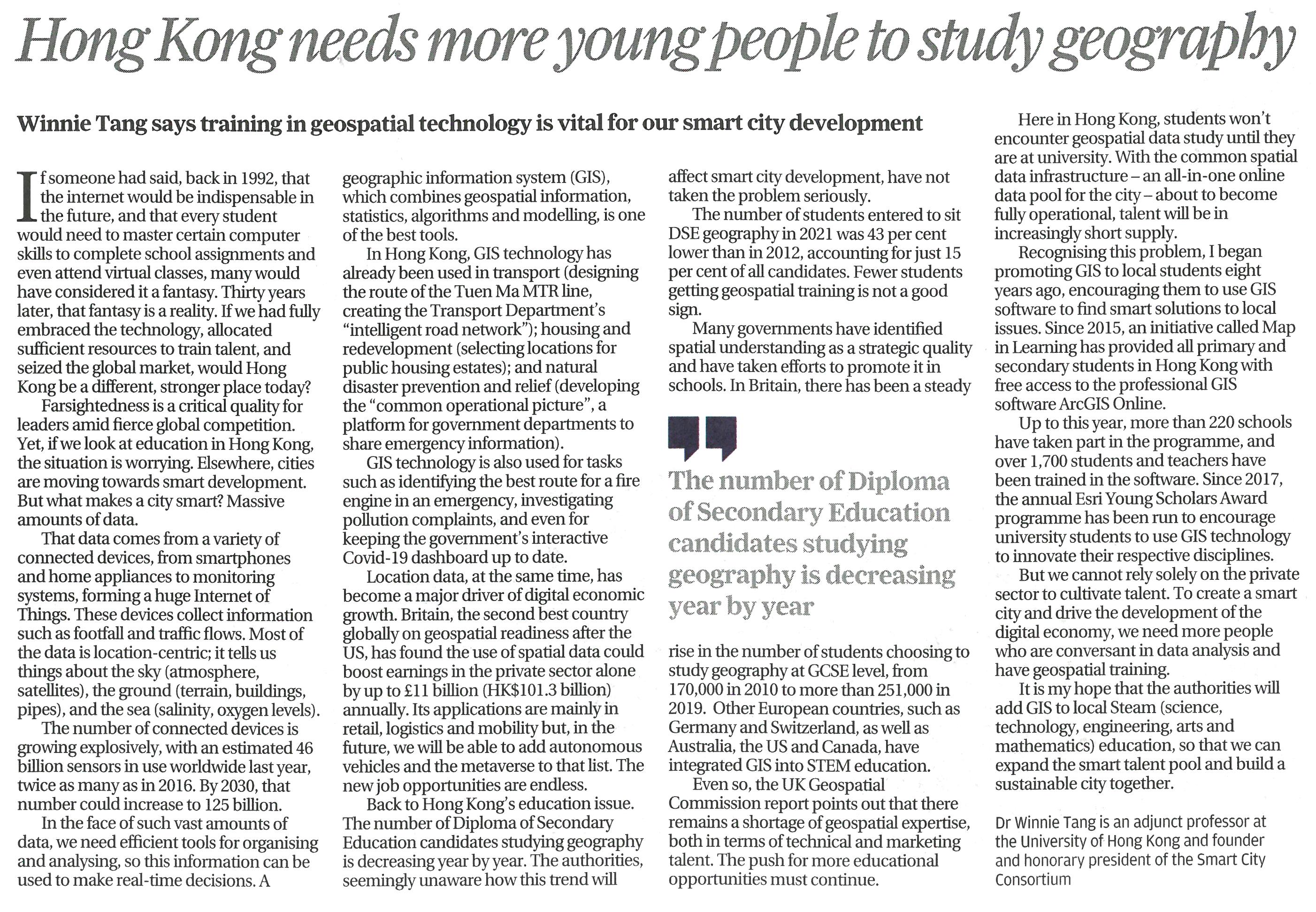網上版請按此

Hong Kong needs more young people to study geography
If someone has said, back in 1992, that the internet would be indispensable in the future, and that every student would need to master certain computer skills to complete school assignments and even attend virtual classes, many would have considered it a fantasy. Thirty years later, that fantasy is a reality. If we had fully embraced the technology, allocated sufficient resources to train talent, and seized the global market, would Hong Kong be a different, stronger place today?
Farsightedness is a critical quality for leaders amid fierce global competition. Yet, if we look at education in Hong Kong, the situation is worrying. Elsewhere, cities are moving towards smart development. But what makes a city smart? Massive amounts of data.
That data comes from a variety of connected devices, from smartphones and home appliances to monitoring systems, forming a huge Internet of Things. These devices collect information such as footfall and traffic flows, temperature and humidity, and light levels. Most of the data is location-centric; it tells us things about the sky (atmosphere, satellites), the ground (terrain, buildings, pipes), and the sea (salinity, oxygen levels).
The number of connected devices is growing explosively, with an estimated 46 billion sensors in use worldwide last year, twice as many as in 2016. By 2030, that number could increase to 125 billion.
In the face of such vast amounts of data, we need efficient tools for organising and analysing, so this information can be used to make comprehensive and real-time decisions. A geographic information system (GIS), which combines geospatial information, statistics, algorithms and modelling, is one of the best tools.
In Hong Kong, GIS technology has already been used in transport (designing the route of the Tuen Ma MTR line, creating the Transport Department's "intelligent road network"); housing and redevelopment (selecting locations for public housing estates, redeveloping old districts under the Urban Renewal Authority); and natural disaster prevention and relief (developing the "common operational picture", a platform for government departments to share emergency information).
GIS technology is also used for tasks such as identifying the best route for a fire engine in an emergency, investigating pollution complaints, and even for keeping the government's interactive Covid-19 dashboard up to date.
Location data, at the same time, has become a major driver of digital economic growth. The UK, the second best country globally on geospatial readiness after the US, has found that the use of spatial data could boost earnings in the private sector alone by up to £11 billion (US$12.8 billion) annually. Its current applications are mainly in retail, logistics and mobility but, in the future, we will be able to add autonomous vehicles and the metaverse to that list. The new employment opportunities are endless.
Back to Hong Kong's education issue. The number of Diploma of Secondary Education candidates studying geography is decreasing year by year. The authorities, seemingly unaware how this trend will affect Hong Kong's smart city development, have not taken the problem seriously.
The number of students entered to sit DSE geography in 2021 was 43 per cent lower than in 2012, accounting for just 15 per cent of all candidates. Fewer students getting geospatial training is not a good sign.
Many governments have identified spatial understanding as a strategic quality and have taken efforts to promote it in schools. In the UK, there has been a steady rise in the number of students choosing to study geography at GCSE level, from 170,000 in 2010 to more than 251,000 in 2019 – an increase of nearly 50 per cent. Other European countries, such as Germany and Switzerland, as well as Australia, the US and Canada, have integrated GIS into Stem education.
Even so, the UK Geospatial Commission report points out that there remains a shortage of geospatial expertise, both in terms of technical and marketing talent. The push for more educational opportunities must continue.
Here in Hong Kong, students won't encounter geospatial data study until they are at university. With the common spatial data infrastructure – an all-in-one online data pool for the city – about to become fully operational, talent will be in increasingly short supply.
Recognising this problem, I began promoting GIS to local students eight years ago, encouraging them to use GIS software to find smart solutions to local issues. Since 2015, an initiative called Map in Learning has provided all primary and secondary students in Hong Kong with free access to the professional GIS software ArcGIS Online.
Up to this year, more than 220 schools have taken part in the programme, and over 1,700 students and teachers have been trained in using the software. Since 2017, the annual Esri Young Scholars Award programme has been run to encourage university students to use GIS technology to innovate their respective disciplines.
But we cannot rely solely on the private sector to cultivate talent. To create a smart city and drive the development of the digital economy, we need more people who are conversant in data analysis and have geospatial training.
It is my hope that the authorities will add GIS to local Steam (science, technology, engineering, arts and mathematics) education, so that we can expand the smart talent pool and build a sustainable city together.
Dr. Winnie Tang
Adjunct Professor, Department of Computer Science, Faculty of Engineering; Department of Geography, Faculty of Social Sciences; and Faculty of Architecture, The University of Hong Kong